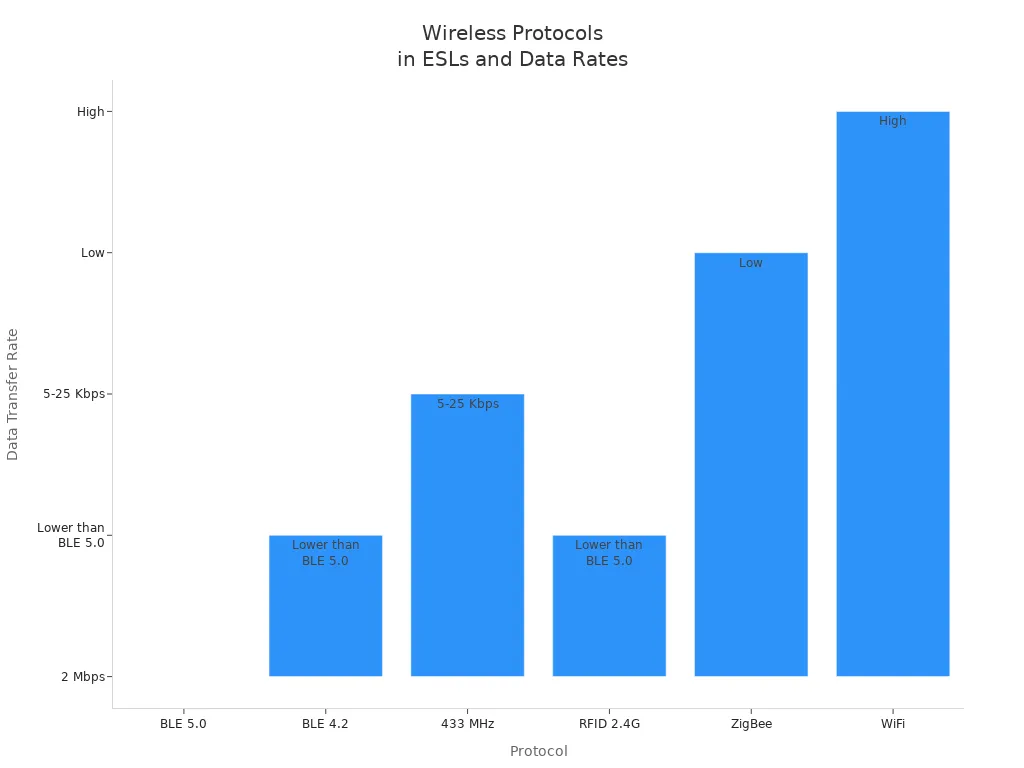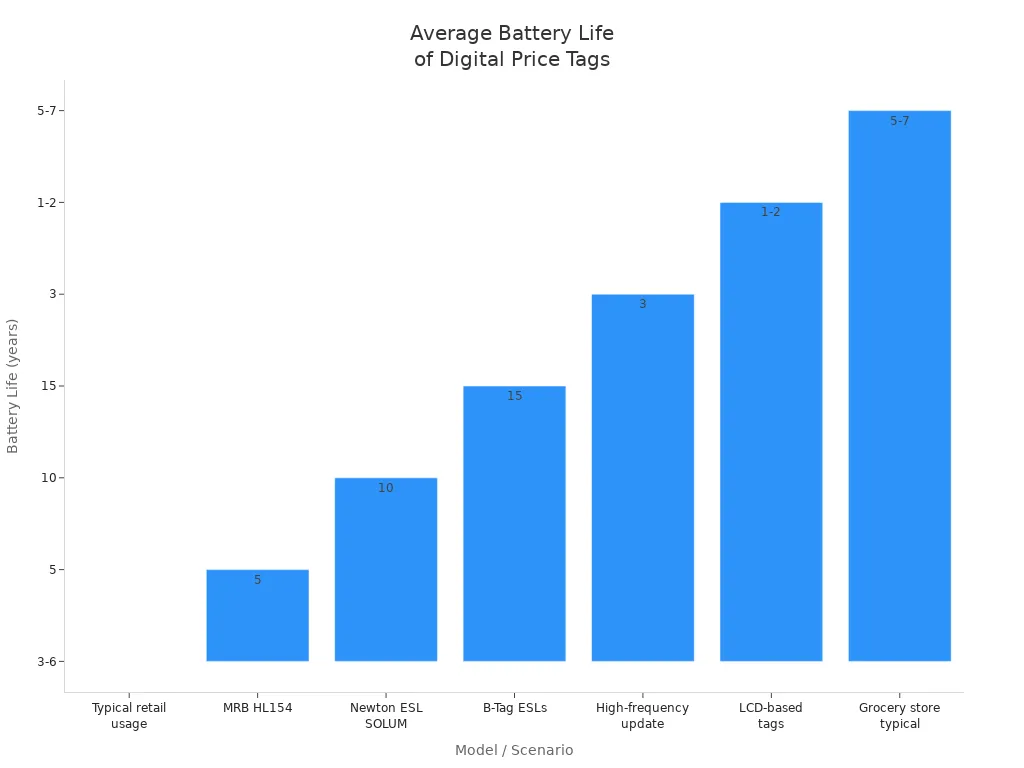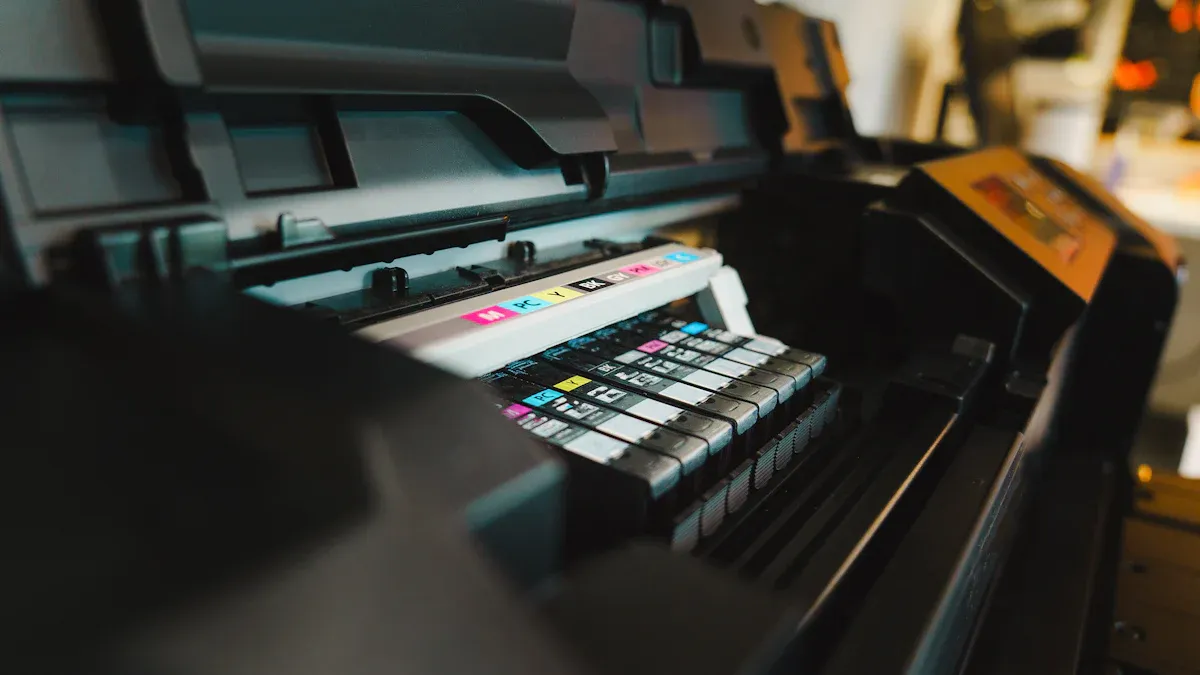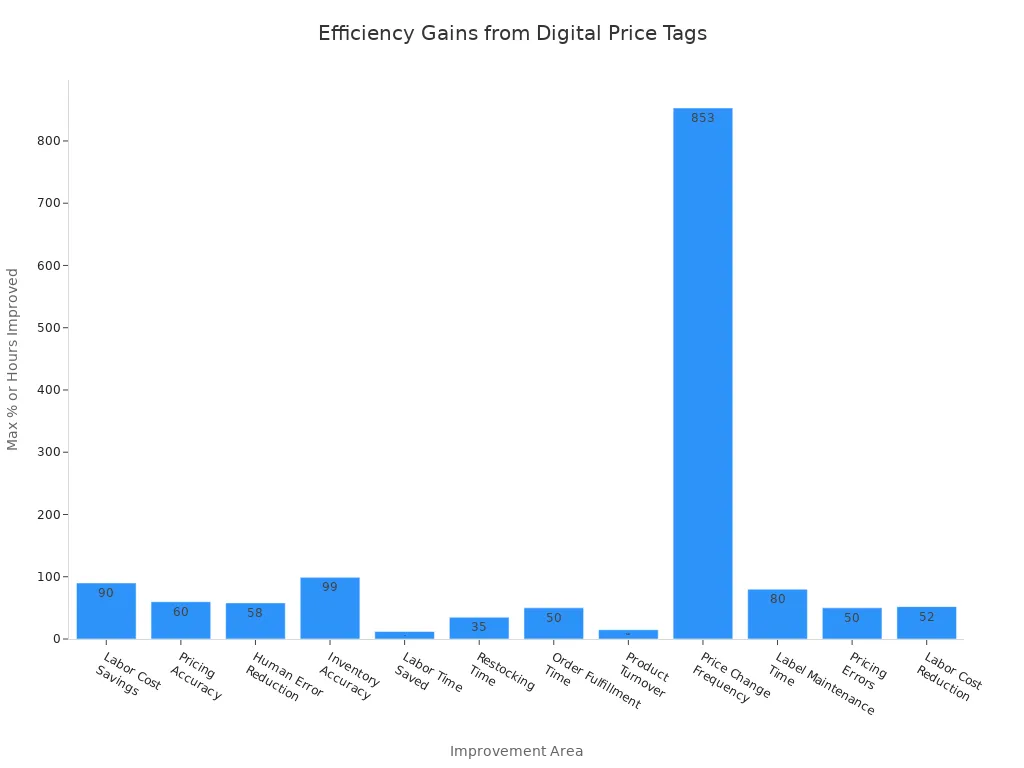
Digital labels transform how information appears in retail and other sectors. They display real-time data electronically, using wireless networks and centralized control. By connecting to an ESL Gateway AP, Electronic Shelf Labels receive instant updates from a central system, allowing stores like Esl Retail to change pricing or promotions within minutes. The following table highlights the clear advantages over traditional methods:
| Aspect | Digital Labels | Traditional Labels |
|---|---|---|
| Update Speed | Real-time, automated | Manual, slow |
| Labor Time | Up to 80% reduction | Labor-intensive |
| Accuracy | Near elimination of pricing errors | Prone to human error |
Efficient power management and technologies such as the ESL Price Tag ensure reliable operation for every application.
The Technology Behind Digital Labels

Digital labels rely on a combination of advanced display technologies, robust wireless communication, and efficient power management. These elements work together to deliver reliable, scalable, and sustainable solutions for modern retail and other industries.
Display Types in Digital Labels
The display is the most visible component of any digital label system. Different technologies offer unique advantages in terms of clarity, energy consumption, and durability.
E-paper Displays
E-paper displays have become a popular choice for electronic shelf labels. Their paper-like appearance and ability to maintain static images without power make them ideal for price tags and signage that require infrequent updates. E-paper technology uses bi-stable materials, which means the display only consumes energy when the content changes. This feature extends operational life and reduces maintenance needs.
E-paper displays generally last up to 10 years or about 50,000 hours, with some models supporting up to 90 million refreshes. Their durability and low energy requirements make them suitable for high-traffic environments. E Ink displays, a common type of e-paper, are lightweight, flexible, and less prone to damage compared to glass-based LCDs or LEDs. Retailers benefit from reduced operational costs and environmental impact due to fewer replacements and lower energy use.
Fully graphic e-paper displays are experiencing rapid growth in the electronic shelf label market. These displays support detailed graphics, animations, and high-resolution images. Their adaptability to different lighting conditions and real-time content updates make them highly effective for dynamic retail environments.
LCD and LED Screens
Liquid Crystal Displays (LCD) and Light Emitting Diode (LED) screens remain widely used in digital price tags. LCDs lead in global revenue share due to their energy efficiency and versatility across various applications. They consume less power than older CRT displays and provide clear, readable information.
However, LCD and LED screens require continuous power to maintain their display. This need for constant energy results in shorter lifespans and more frequent maintenance compared to e-paper. LCD-based digital price tags typically last one to two years under normal usage, making them less suitable for applications where long-term reliability is critical.
The following table compares the main display technologies used in digital labels:
| Display Technology | Market Position / Share | Key Characteristics and Trends |
|---|---|---|
| Liquid Crystal Displays (LCD) | Expected to lead in global revenue share | Widely used, energy-efficient, popular across many applications, consumes less power than CRT displays. |
| Segmented E-paper Displays | Steady revenue growth expected | Reflective display, low power consumption, uses technologies like electrochromism, suitable for low-frequency updates. |
| Fully Graphic E-paper Displays | Projected highest CAGR during forecast period | Can display detailed graphics, animations, high-resolution images; low power usage; gaining traction in retail. |
Note: Fully graphic e-paper displays outperform segmented e-paper and LCD technologies by offering detailed graphics and animations with very low power consumption.
Wireless Communication for Electronic Shelf Labels
Reliable wireless communication forms the backbone of electronic shelf label systems. It enables real-time updates, remote management, and seamless integration with store operations.
Wi-Fi Connectivity
Wi-Fi provides high data rates and supports a large number of connected devices. In retail environments, robust Wi-Fi infrastructure ensures continuous operation and minimal downtime for digital systems. High-speed retail Wi-Fi powers connected devices, IoT sensors, and real-time data analytics. Scalable Wi-Fi solutions grow with business needs, accommodating more devices and higher data demands. Built-in network redundancy offers resilience against outages, maintaining seamless operations.
Bluetooth and RF Protocols
Bluetooth Low Energy (BLE) has emerged as the global standard for wireless communication in electronic shelf labels. BLE 5.0 supports bidirectional communication with thousands of devices from a single access point. It offers a data transfer rate up to 2 Mbps, which is significantly higher than other protocols. BLE includes advanced security features such as AES-128 encryption, ensuring secure data transfer.
Other protocols, such as 433 MHz RF, RFID 2.4G, and ZigBee, see limited use due to lower data rates, security concerns, or higher latency. BLE 5.0 stands out for its low power consumption, long range, and strong anti-interference capabilities. The adoption of Bluetooth standards continues to drive growth in the electronic shelf label market.
| Protocol | Usage in ESLs | Data Transfer Rate | Advantages | Disadvantages |
|---|---|---|---|---|
| BLE 5.0 | Mainstream technology | Up to 2 Mbps | High security (AES-128), long distance, low power consumption, strong anti-interference, firmware OTA updates | |
| BLE 4.2 | Used in ESLs | Lower than BLE 5.0 | Standardized Bluetooth protocol benefits | Lower data rate than BLE 5.0 |
| 433 MHz | Custom/independent | ~5-25 Kbps | Low cost, long distance | Poor security, unstable communication due to narrowband AM, poor anti-multipath effect |
| RFID 2.4G | Used in ESLs | Lower than BLE 5.0 | Frequency modulation, moderate range | Limited channels, single frequency, limited anti-interference |
| ZigBee | Less suitable | Low | Low power | Low communication rate, limited distance, high latency |
| WiFi | Less suitable | High (not specified) | High data rate | High power consumption, high cost, complex coding |

Tip: BLE 5.0 enables scalable and secure communication, making it the preferred choice for large-scale deployments of electronic shelf labels.
Power Sources for Digital Price Tags
Efficient power management is essential for the long-term operation of digital price tags. The choice of power source impacts maintenance schedules, operational costs, and sustainability.
Battery-Powered Labels
Most digital price tags use coin cell batteries, such as CR2032, CR2450, or CR2477. E-paper-based tags typically achieve battery lifespans of three to six years with two to three updates per day. Advanced models, like the Newton ESL by SOLUM, can last up to ten years, while some systems with optimized hardware and software reach up to fifteen years. LCD-based tags, which require continuous power, usually last one to two years.
| Product Model / Scenario | Average Battery Life | Battery Type | Notes / Conditions |
|---|---|---|---|
| Typical retail usage (2-3 updates/day) | 3 to 6 years | Coin cell (CR2032, CR2450, CR2477) | E-paper technology; power used only during updates |
| MRB digital price tag HL154 | ~5 years | CR2450 | User-replaceable battery under normal use |
| Newton ESL by SOLUM | Up to 10 years | Not specified | Optimized hardware/software, supports heavy use |
| B-Tag ESLs | Up to 15 years (rare cases) | Not specified | Includes battery management system |
| High-frequency update environments | Around 3 years | Coin cell | Frequent updates reduce battery life |
| LCD-based digital price tags | 1 to 2 years | Various | Continuous power draw reduces lifespan |
| Grocery store typical environment | 5 to 7 years | Coin cell | Moderate update frequency, ambient conditions |

Environmental factors, such as temperature and humidity, also influence battery performance. E-paper displays extend battery life by consuming power only during updates, making them more efficient than LCD-based tags.
Energy Harvesting Solutions
Energy harvesting technologies further enhance the sustainability and operational life of digital labels. These solutions capture ambient energy, such as indoor light, to supplement or replace batteries. Photovoltaic cells convert light into electricity, which powers the device or recharges its battery. Power management ICs ensure efficient energy conversion and battery protection.
- Energy harvesting can eliminate the need for disposable batteries, reducing e-waste and maintenance costs.
- Bluetooth low power technology works well with energy harvesting, lowering overall device power consumption.
- Devices with consistent energy harvesting operate maintenance-free, supporting scalability in large retail environments.
- A major supermarket chain deployed electronic shelf labels powered by energy harvesting, achieving uninterrupted operation and meeting sustainability goals.
Note: Energy harvesting enables maintenance-free operation and can extend battery life to match the device’s lifetime, supporting real-world retail applications.
The combination of advanced display types, robust wireless communication, and efficient power sources forms the foundation of modern digital label systems. These technologies enable real-time updates, reduce operational costs, and support the growing demand for sustainable solutions in retail and beyond. As the types of digital label printing continue to evolve, businesses can expect even greater flexibility and efficiency from their digital labeling strategies.
Digital Label Printing and Data Management

Digital Label Printing Process
Design Creation and File Preparation
The digital label printing process begins with careful design creation. Designers use graphic software to develop label layouts, considering dimensions, color accuracy, and file formats. They prepare artwork that aligns with brand guidelines and product requirements. During this stage, digital label printing allows for easy adjustments and corrections, even late in the process. This flexibility reduces the risk of costly errors, which often occur in traditional offset printing when mistakes require redoing print plates and restarting production.
Printing Setup and Execution
After finalizing the design, operators prepare the digital label printer for production. The pre-press process includes calibrating color separation, proofing, and selecting cutting methods. The digital label printer applies ink directly to the substrate, producing vibrant and accurate colors. Post-press checks ensure the printed labels meet quality standards and client preferences. Finishing steps, such as slitting, rewinding, and packaging, complete the process. Digital label printing supports rapid turnaround and lower error rates compared to traditional methods, thanks to its proofing capabilities and streamlined workflow.
Tip: Digital label printing enables on-demand production, making it ideal for businesses that require frequent updates or small batch runs.
Central Management Systems for Digital Labels
Software Platforms
Central management systems play a crucial role in digital label printing and deployment. These platforms integrate with point-of-sale (POS), retail management, and inventory systems, ensuring pricing consistency across all locations. Automated bulk price adjustments and scheduled promotions allow businesses to update information rapidly and accurately. Remote monitoring features track label functionality and battery life, reducing the need for physical checks. Software updates can be deployed remotely, saving time and resources.
User Interfaces
User interfaces for digital label printing systems prioritize ease of use and efficiency. Employees access dashboards to manage label content, schedule updates, and monitor device status. Centralized real-time price updates eliminate manual labor and reduce human errors. Synchronization with promotions and POS systems ensures consistent information across all channels. By simplifying inventory management and freeing employees from repetitive tasks, these systems increase productivity and reduce operational costs.
| Feature | Benefit |
|---|---|
| Centralized price updates | Consistent pricing, fewer errors |
| Bulk changes | Fast updates across multiple locations |
| Inventory synchronization | Simplified stock management |
| Remote monitoring | Reduced maintenance effort |
Cloud Integration and Real-Time Updates
Remote Access and Control
Cloud integration enhances the scalability of digital label printing deployments. Remote access and control features enable centralized management of thousands of digital labels across multiple locations. Administrators can adjust orientation, update content, push firmware, and reboot devices without onsite visits. Automated diagnostics and real-time alerts maintain high system reliability and uptime. Cloud-based dashboards support bulk deployment, device grouping, and scheduling, streamlining rollout and ongoing management.
- Remote access eliminates the need for physical intervention.
- Automated troubleshooting ensures continuous operation.
- Cloud dashboards simplify large-scale deployments.
Security and Data Protection
Cloud-connected digital label printing systems face unique security challenges. APIs and interfaces may expose vulnerabilities if not properly secured. Misconfigurations, which account for a significant portion of cloud security issues, can lead to data exposure. Data breaches, denial-of-service attacks, insider threats, and phishing attempts also pose risks. To address these concerns, organizations implement end-to-end encryption, data loss prevention, continuous auditing, multi-factor authentication, and cloud security posture management tools. These measures protect sensitive information and ensure compliance with industry standards.
Note: Robust security practices are essential for protecting digital label printing systems that rely on cloud integration and real-time updates.
Installation and Setup of Electronic Shelf Labels
Initial Configuration Steps
Connecting to Network
Technicians begin the setup of electronic shelf labels by connecting each device to the store’s network. They configure gateways and access points to ensure stable communication between digital price tags and the central management system. Signal interference and communication limitations often present technical challenges. Proper planning and robust infrastructure help minimize connectivity problems. Staff training plays a vital role in overcoming adaptation barriers, as employees must learn new workflows and system operations.
Note: High upfront costs, including purchasing labels, gateways, and software, require careful budgeting during initial configuration.
Assigning Label Locations
After network connection, installers assign each electronic shelf label to its designated shelf or product location. Accurate mapping ensures that digital price tags display correct information for each item. Device malfunctions, such as software errors, can propagate across the system if not addressed early. Comprehensive training and systematic assignment procedures help prevent errors and streamline future updates.
Physical Installation of Digital Labels
Mounting Options
Retailers select mounting options based on store layout and traffic patterns. ESL holders provide strong, durable mounting that protects digital labels from physical damage caused by carts or bumps. Enhanced durability ensures that digital price tags remain visible and functional, even in high-traffic areas. Real-time updates improve visibility by keeping prices and promotions accurate without manual intervention. A convenience store chain demonstrated the importance of secure mounting on wire cooler shelves, highlighting the need for environment-specific solutions.
- ESL holders withstand regular use and shelf stability.
- Traditional holders require frequent replacements and offer less protection.
Environmental Considerations
Environmental hazards threaten the durability and legibility of digital labels. UV radiation, extreme temperatures, moisture, chemicals, and abrasion can damage labels and reduce visibility. Selecting materials such as vinyl, polyester, polypropylene, or aluminum helps withstand these hazards. Protective laminates and strong adhesives ensure labels remain adhered and clear over time. Field testing in actual conditions verifies the effectiveness of mounting and material choices.
Tip: Industrial-grade printing technologies and protective overlaminates support long-lasting, visible digital price tags in challenging environments.
Ongoing Maintenance for Digital Price Tags
Battery Replacement
Regular battery replacement keeps digital price tags operational. Most systems use coin cell batteries, which require periodic checks and replacement based on usage frequency and environmental conditions. Maintenance schedules recommend inspecting power systems quarterly and testing backup systems to prevent downtime.
Software Updates
Software updates maintain system security and functionality. Technicians update software and firmware monthly to address vulnerabilities and improve performance. Daily checks verify that displays function properly and monitor for errors or warnings. Weekly inspections include cleaning screens and testing connectivity.
| Maintenance Frequency | Recommended Tasks |
|---|---|
| Daily | Verify displays, check content scheduling, monitor for errors |
| Weekly | Inspect screens, clean areas, test connectivity |
| Monthly | Test network, update software, review content strategy |
| Quarterly | Deep clean hardware, inspect power systems, review logs |
Regular maintenance prevents display malfunctions, extends equipment lifespan, and ensures clear, uninterrupted content for customers.
Practical Applications of Digital Labels Across Industries
Retail and Digital Price Tags
Price Tagging and Promotions
Retailers deploy digital price tags to streamline price management and promotional activities. These electronic displays connect directly to store databases, replacing manual paper or plastic tags. Automatic updates across multiple locations reduce the need for staff to physically change price tags. Employees can focus on customer service and inventory management, improving morale and operational efficiency. Real-time synchronization between shelf prices and POS systems ensures customers see accurate prices, especially during sales or promotions. Retailers benefit from dynamic pricing capabilities, adjusting prices based on demand, seasonality, or competitor activity. Updating thousands of price tags takes minutes, not hours, which lowers labor costs and enhances profitability.
- Digital shelf labels eliminate manual price updates.
- Real-time price synchronization prevents checkout discrepancies.
- Agile pricing strategies support operational efficiency.
Inventory Management
Digital label printing solutions in retail environments enhance inventory management. Digital labels sync with inventory software, triggering automatic restocking alerts and preventing stock shortages. Employees receive real-time notifications for restocking, increasing efficiency. Integration with expiration tracking allows automatic discounting of near-expiry items, reducing food waste. E-paper technology in digital labels consumes minimal power, supporting sustainability. Retailers monitor stock levels, assign specific labels, and modify layouts centrally. Integration with e-commerce platforms aligns physical and online inventories, improving supply management and employee productivity.
- Real-time stock tracking and automated restocking alerts.
- Programmable LED indicators provide visual cues for inventory actions.
- Reduced paper waste and improved sustainability.
Foodservice and Digital Food Labels
Menu Boards and Ingredient Lists
Foodservice operators use digital food labels to display menu items and ingredient lists with clarity and flexibility. Digital menu boards enable instant updates to menu items, prices, and promotions, adapting quickly to inventory changes or seasonal offerings. Centralized control streamlines operations and reduces downtime. Customers benefit from clear, engaging displays that enhance satisfaction and reduce decision time. Digital label printing eliminates frequent reprints, saving costs and supporting environmental sustainability.
| Benefit | Explanation |
|---|---|
| Real-time Updates | Instant changes to menu items, pricing, and promotions ensure accuracy and responsiveness. |
| Cost Reduction | Eliminates printing and manual update costs. |
| Operational Efficiency | Centralized control streamlines operations. |
| Customer Experience | Clear, up-to-date information improves satisfaction. |
| Sales Growth | Dynamic content management increases revenue. |
| Environmental Sustainability | Reduces paper waste by replacing printed menus. |
Allergen and Nutrition Information
Digital food labels play a vital role in communicating allergen and nutrition information. Allergen details appear in bold text and with recognizable icons, improving consumer safety. Labels include ingredient lists, allergen disclosures, and nutrition facts, helping guests make informed choices. Large fonts, high contrast, and proper placement next to dishes enhance readability. Digital label software automates allergen detection, recipe updates, and regulatory compliance. Customizable templates allow images, multiple languages, and QR codes for additional information. Regular updates and quality control prevent mislabeling and ensure accuracy. Integrated solutions enable foodservice operators to manage recipes, track allergens, and update nutrition information efficiently, supporting compliance and improving both front-of-house and kitchen operations.
- Digital buffet labels display dish names, dietary icons, and nutrition facts in real time.
- Centralized management enables instant updates across multiple locations.
- Multilingual support and allergen-friendly icons improve clarity for diverse guests.
- Hybrid approaches balance cost and flexibility for frequently changing dishes.
Packaging, Logistics, and Digital Label Printing
Tracking Shipments
Digital label printing solutions transform logistics by enabling automatic tracking and real-time data collection. IoT-enabled labels monitor environmental conditions such as temperature and humidity during transit. Serialized track-and-trace technology assigns unique digital identities to products, providing end-to-end visibility from production to distribution. Smart labels deliver real-time alerts for counterfeit detection, shelf-life expiration, and shipping updates. Integration of NFC, RFID, and serialized barcodes enhances traceability and security.
- Digital labels improve supply chain transparency and operational efficiency.
- Real-time data from smart labels supports product integrity and tamper-evident security.
Dynamic Product Information
Digital label printing enables variable data printing, such as barcodes, QR codes, and unique product details, allowing personalized and dynamic labeling. QR codes on labels provide interactive access to detailed product information, connecting physical products to digital content. Smart labels incorporating NFC and augmented reality offer instant product information, authenticity verification, and enhanced consumer engagement. Integration with RFID and IoT solutions provides deeper insights into consumer behavior and supply chain transparency.
- Digital food labels support dynamic product information and authenticity verification.
- Smart labels transform static packaging into tools for enhanced engagement and insights.
Healthcare and Electronic Shelf Labels
Electronic shelf labels have become essential tools in modern healthcare environments. Hospitals and clinics use these digital solutions to improve patient safety, streamline workflows, and enhance operational efficiency. Their ability to provide real-time updates and automate information management supports better care delivery and resource utilization.
Patient Information Displays
Hospitals deploy electronic shelf labels to display up-to-date patient information at the point of care. These digital displays present critical details such as patient names, room numbers, medication schedules, and care instructions. Staff can update information instantly through centralized systems, reducing the risk of outdated or incorrect data.
Note: Real-time updates on patient room and bed assignments, medication schedules, and inventory levels help staff respond quickly to changing needs.
Advanced electronic shelf labels feature multi-color displays and durable designs suitable for hospital environments. These features allow for easy monitoring of patient status and quick identification of urgent cases. The integration with hospital information systems enables automated alerts for medication administration times, allergy warnings, and special care requirements. This automation reduces manual data entry, minimizes human error, and allows healthcare professionals to focus more on direct patient care.
The use of electronic shelf labels also supports sustainability goals. By replacing paper-based systems, hospitals reduce paper waste and lower long-term costs. Automated updates further decrease labor expenses, contributing to more efficient operations.
Medication Tracking
Accurate medication tracking remains a top priority in healthcare settings. Digital labels play a crucial role by encoding essential data such as National Drug Code (NDC) numbers, lot numbers, and expiration dates using advanced barcodes like GS1 DataMatrix and Code 128. Automated verification systems scan these barcodes before medication administration, ensuring the right drug reaches the right patient.
RFID smart labels take medication tracking a step further. Each medication receives a unique identifier linked to the hospital database, enabling real-time tracking and authentication. Staff can quickly verify medication authenticity and match it to the correct patient, reducing the risk of errors and counterfeit drugs. Smart cabinets with RFID integration provide instant inventory visibility, ensuring timely use of medications and reducing manual inventory tasks.
Hospitals that implement these digital tracking systems report significant improvements. For example, automated inventory management reduces manual counting time and operational costs. Real-time alerts about stock outs, substitutions, and expiration dates help clinical teams maintain safe and efficient medication practices.
Tip: Investing in updated labeling software, high-resolution printers, and staff training ensures reliable scanning and maximizes the benefits of digital medication tracking.
Electronic shelf labels, when integrated with medication tracking technologies, enhance patient safety, support regulatory compliance, and streamline pharmacy operations.
Benefits and Advantages of Digital Labels
Efficiency and Speed of Digital Price Tags
Instant Updates
Digital labels deliver rapid updates across entire retail environments. Automated systems push new prices, promotions, or product information to thousands of tags in seconds. Retailers no longer rely on manual processes that take hours or even days. This speed enables stores to respond quickly to market changes, competitor pricing, or inventory shifts. The following table highlights measurable improvements observed in leading retailers:
| Improvement Area | Measurable Outcome |
|---|---|
| Labor Cost Savings | Up to 90% reduction due to automation of price updates and inventory checks |
| Labor Time Saved | Up to 12 hours saved per week per store by automating price updates |
| Price Change Frequency | Increased by 54% to 853% in some retailers, enabling faster market response |
| Label Maintenance Time | Reduced by 80% (e.g., Carrefour) |
| Order Fulfillment Time | Reduced by up to 50% via digital shelf label features |

Retailers such as Carrefour and Tesco have reported that digital price tags allow them to roll out new products and promotions much faster, improving their ability to compete.
Reduced Manual Labor
Automated digital label systems significantly reduce the need for manual labor. Employees no longer spend hours replacing paper tags or checking inventory by hand. Automation leads to up to 90% labor cost savings and allows staff to focus on customer service and other high-value tasks. Stores save up to 12 hours per week per location, streamlining operations and reducing operational costs.
Accuracy and Reliability of Electronic Shelf Labels
Error Reduction
Electronic shelf labels (ESLs) automate price updates and inventory tracking, which minimizes human error. Real-time updates eliminate mistakes common in manual labeling, such as incorrect prices or outdated promotions. One retailer completed 1,400 price changes in under 10 minutes using ESLs—a task that previously took four days. Integration with cloud platforms ensures shelf labels and POS systems always match, reducing pricing errors by up to 50%.
Consistent Information
ESLs provide consistent and reliable information throughout the store. Automated updates ensure that every label displays accurate pricing and product details at all times. Employees spend 80% less time on price updates, which improves overall efficiency and allows them to focus on customer needs. Shoppers benefit from always-accurate pricing and real-time promotions, enhancing satisfaction and trust.
Sustainability of Digital Food Labels
Reduced Paper Waste
Digital food labels help reduce paper waste by eliminating the need for printed paper tags. Traditional paper labels are often discarded after short use and are rarely recyclable due to adhesives. In 2017, UK printing companies sent over 264 million pounds of label waste to landfills. Digital food labels last for years, reducing the frequency of replacements and minimizing environmental impact. On-demand digital printing also reduces excess materials and ink waste, supporting more sustainable operations.
Energy Efficiency
Digital label printing systems achieve greater energy efficiency compared to traditional methods. Automated updates and reduced physical waste lower overall energy consumption. Retailers have reported up to 40% energy savings over five years after switching to electronic pricing solutions. Digital printers use up to 30% less energy per label than traditional flexographic presses, as they do not require heating plates or heavy machinery. This efficiency supports both cost savings and environmental goals.
Digital food labels not only reduce paper waste but also contribute to energy-efficient operations, making them a sustainable choice for modern businesses.
Cost-Effectiveness of Digital Label Printing
Long-Term Savings
Digital label printing offers substantial long-term savings for businesses, especially large-scale retailers. Companies that switch to digital label printing benefit from advanced die-less finishing technology. This innovation reduces per-label costs from 10-20 cents to as low as 0.2 cents. In-house die-less finishing eliminates the need for expensive dies and shortens wait times for new label designs.
Retailers also see savings through intelligent optical registration and error detection, which minimize label waste and inefficiencies. High-speed roll-to-roll digital converting systems streamline production by laminating, cutting, stripping, and slitting labels in a single pass. These improvements make digital label printing cost-effective for both large-scale and short-run production.
- Die-less finishing reduces material costs and speeds up design changes.
- Automated systems cut labor expenses by eliminating manual price updates.
- Real-time price updates across multiple locations improve operational efficiency.
- Dynamic pricing capabilities enhance profitability by responding quickly to market changes.
Large retailers with thousands of displays often recoup their investment in digital label printing within a year. Automated systems prevent pricing errors, which helps avoid lost sales and compliance risks. The advantages of digital label printing extend beyond cost savings, improving customer experience with accurate and timely information.
Lower Maintenance Costs
Digital label printing systems require less maintenance than traditional labeling methods. Flexographic printing involves multiple setup steps, such as artwork preparation, plate making, press setup, ink mixing, and machine calibration. Each step adds to maintenance and operational costs.
Digital label printing eliminates most of these steps, leaving only artwork preparation. This reduction in complexity leads to lower labor costs and fewer opportunities for errors. Maintenance teams spend less time troubleshooting and more time on productive tasks.
- Minimal setup requirements reduce downtime and maintenance needs.
- Fewer moving parts and consumables lower the risk of equipment failure.
- Automated error detection ensures consistent quality and reduces rework.
Note: Companies that adopt digital label printing experience a direct reduction in maintenance costs, making it a smart investment for long-term operations.
Digital label printing not only streamlines production but also supports sustainability goals by reducing waste and energy use. These factors combine to make digital label printing a cost-effective solution for modern businesses.
Challenges and Considerations for Digital Labels
Digital labels offer many advantages, but organizations must address several challenges before and during deployment. These considerations include upfront investment, technical limitations, and security requirements.
Initial Investment in Digital Label Printing
Upfront Costs
Implementing digital label printing in retail or other environments involves significant initial expenses. The total cost depends on the number of labels, display size, and technology features. The following table summarizes typical cost components:
| Cost Component | Description / Price Range |
|---|---|
| Label Price per Unit | $5–$15 (1.5″–2.5″), $15–$30 (3″–4.2″), $30–$100+ (5″+, premium) |
| Bulk Discounts | Available for large orders, reducing per-unit cost |
| Pricing Models | One-time purchase, subscription, or leasing |
| Installation Fees | Vary by provider; professional setup often recommended |
| Software Licensing | Upfront or subscription-based fees |
| Battery Replacement & Maintenance | E-paper lasts 5+ years; LCD/color displays need more frequent changes |
| Gateways (hardware) | $300–$400 per unit |
| ESL Management Software | Around $500 upfront, sometimes subscription-based |
One-time purchases require higher upfront investment but lower long-term costs. Subscription and leasing options reduce initial spending but add ongoing fees. Hidden costs, such as installation and maintenance, can impact the total budget.
ROI Analysis
Decision-makers must evaluate the return on investment (ROI) for digital label printing. While upfront costs can reach thousands of dollars, automation and reduced labor often offset these expenses over time. Bulk discounts and leasing options help manage capital expenditure. Professional installation ensures reliable performance, minimizing costly errors. Battery replacement schedules and software licensing also affect long-term ROI. Careful analysis of store size, update frequency, and operational needs supports informed investment decisions.
Technical Limitations of Electronic Shelf Labels
Connectivity Issues
Electronic shelf labels (ESLs) rely on wireless protocols like Bluetooth, Wi-Fi, or RF for real-time updates. Reliable connectivity ensures accurate pricing and inventory information. However, interference from other electronic devices or crowded wireless environments can disrupt communication. Store size and building layout influence wireless coverage and update speed. Poor connectivity may cause delays or failures in price updates, reducing operational efficiency.
- ESL systems must use distinct frequencies to avoid interference with store Wi-Fi.
- Frequent updates can drain batteries faster, requiring careful balance between update speed and power consumption.
- Scalable wireless solutions should match the store’s architecture and size.
Compatibility Concerns
Compatibility with existing network infrastructure and warehouse management systems is essential. Integration challenges may arise if the digital label system does not align with current software or hardware. Network limitations or outdated systems can hinder seamless deployment. Organizations must assess compatibility early to prevent operational delays and increased maintenance.
- Network infrastructure must support the chosen wireless technology.
- Integration with inventory and POS systems ensures smooth operation.
- Incompatible systems can lead to data errors and reduced accuracy.
Security and Privacy in Digital Labels
Data Protection Measures
Digital labels handle sensitive pricing, inventory, and operational data. Strong data protection measures are necessary to prevent unauthorized access or data breaches. Encryption, secure wireless protocols, and regular software updates help safeguard information. Organizations should implement multi-factor authentication and monitor system activity for unusual behavior.
Regular security audits and robust encryption protocols protect both customer and business data from cyber threats.
Regulatory Compliance
Businesses must comply with data privacy regulations when deploying digital labels. Requirements may include secure data storage, access controls, and audit trails. Non-compliance can result in legal penalties and reputational damage. Staying updated on relevant laws and industry standards ensures ongoing compliance and protects organizational interests.
- Adherence to data privacy laws is mandatory.
- Regular reviews of compliance policies help avoid regulatory risks.
- Secure management of digital label data supports trust and accountability.
Digital labels combine advanced display technology, wireless communication, and centralized management. Their streamlined setup enables real-time updates and dynamic content across industries. Businesses gain measurable improvements in efficiency, accuracy, and sustainability. Cost-effectiveness remains a key advantage for large and small organizations.
As digital label technology evolves, companies will discover new ways to manage and present information, driving innovation in retail, healthcare, and logistics.
FAQ
What is a digital label?
A digital label displays product or information electronically. It uses technologies such as e-paper, LCD, or LED. These labels connect to a central system for real-time updates and dynamic content.
How long do digital labels typically last?
Most digital labels last three to ten years. Battery life depends on display type, update frequency, and environmental conditions. E-paper models usually offer the longest lifespan.
Can digital labels integrate with existing POS systems?
Yes, most digital label solutions support integration with POS and inventory systems. This ensures consistent pricing and product information across all platforms.
Are digital labels secure?
Digital labels use encryption, secure wireless protocols, and regular software updates. These measures protect sensitive data and help maintain compliance with industry regulations.
What industries benefit most from digital labels?
Retail, foodservice, logistics, and healthcare see the greatest benefits. Digital labels improve efficiency, accuracy, and sustainability in these sectors.
How do digital labels help reduce costs?
Digital labels automate updates and reduce manual labor. They also minimize paper waste and lower maintenance expenses, leading to significant long-term savings.
What happens if a digital label loses connection?
Most digital labels retain the last displayed information until the connection restores. The central system sends updates once connectivity resumes.
Can digital labels display more than just prices?
Yes, digital labels can show promotions, inventory status, nutritional facts, allergen warnings, and tracking information. Their flexibility supports many business needs.


